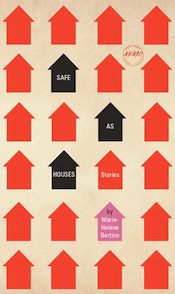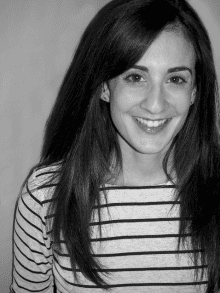
In matters of mystery (ghosts, psychics, horses who can do math), I am a skeptic. My mother’s natural inclination is toward belief. When my parents last took a trip to California, they visited the Santa Cruz Mystery Spot, site of a so-called “gravitational anomaly” whose potential causes range from a magma vortex to a buried spacecraft to an invisible stream of Fantastic Four-style cosmic radiation. After hearing my parents’ description, I chalked up the effect to sideshow flimflammery. But my mother remained convinced. “I could feel it,” she told me, pausing, as if weighing the earth’s pull on her at that very moment. In that spot, she said, the world felt different.
Safe as Houses, Marie-Helene Bertino’s debut short story collection (and winner of the Iowa Fiction Award), is full of off-kilter worlds. The book’s eight trim stories are strange and lovely—to call them quirky feels dismissive; to call them magical feels misleading. Safe as Houses is neither slight nor otherworldly. Instead, in each of her stories, Bertino seems to tweak some grand cosmological constant and set the universe askew, as if for a handful of pages she’d changed the laws of gravity.
The collection’s centerpiece is the Pushcart Prize-winning “North Of,” which begins: “There are American flags on school windows, on cars, on porch swings. It is the year I bring Bob Dylan home for Thanksgiving.” The story’s narrator has returned to Philadelphia, and she’s happened to bring Bob Dylan along. Her brother is about to ship off to Iraq, and she hopes the world-famous singer-songwriter can convince him not to go.
The family’s Thanksgiving dinner, like most holiday meals in fiction, is a disaster. There is minor bloodshed. Dylan turns out to be no help at all, as the narrator explains: “Bob Dylan mopes in the car. I feel saddled with him now. He was supposed to create some sort of lather, and he barely summoned enough energy to behead a pile of string beans.”
The story succeeds because of how Bertino handles having Bob Dylan in her story. You’d expect an eloquent anti-war plea from him at the story’s climax, but she never lets that happen. In fact, Dylan doesn’t utter a single word the entire story. How the narrator got him to come with her is never explained either. Instead, he becomes something else—a silent catalyst that allows the narrator to attempt to fix her relationship with her brother. Dylan’s strange, ghostly presence makes the story happen.
Again and again, Bertino sets up peculiar circumstances and aptly plays them out. In “The Idea of Marcel,” Emily goes on a date with the embodied ideal of her ex-boyfriend, Marcel, only to learn that the real Marcel is out at the same time with an idealized version of her. A door-to-door salesman hocks an array of increasingly surreal items in “This Is Your Will to Live.” Outcast college students experiment with super powers in “Great, Wondrous.”
Along with the imaginative conceits of Safe as Houses, Bertino has a lively prose style, with a knack for figurative language. In “Free Ham,” the collection’s opening story, the narrator’s house burns down. “People drive by,” Bertino writes, “their mouths angel o’s, trying hard to make sense of the house with the fire in it. It is as absurd as a dinosaur, hurling its arms and legs through the eaves and gutters.”
It’s a wonderful moment—comic but not cartoonish—as Bertino coaxes the word “angel” into a verb then conjures up an image that captures the horrific randomness of having one’s house burn down in the middle of the night.
Yet despite Bertino’s clever premises and adroit prose, a degree of sameness creeps into the collection. Her stories, save for the title piece, center on young women, and their voices start to become interchangeable. Here is the opening to “Sometimes You Break Their Hearts, Sometimes They Break Yours”:
I am like everyone else—good at some things, bad at others. I am good at eating clementines. I am bad at drawing straight lines. I am good at drinking coffee. I would be bad at building a house. If someone asked me to build them a house, I would have to say no. Or I would say yes and worry they would not like the house I built.
And the opening to “Carry Me Home, Sisters of Saint Joseph”:
I am quitting a boy like people quit smoking. I am not quitting smoking. The pamphlet insists: Each time you crave a cigarette, eat an apple or start a hobby! Each time I think about Clive, I smoke a cigarette. If I have already smoked a cigarette, I eat an apple. If I have already eaten an apple, I start a hobby. I smoke about two packs a day. I pogo-stick, butterfly-collect, macramé, decoupage. I eat nothing but apples.
These two narrators—a receptionist who may or may not be an alien from a planet with an unpronounceable name and an advertising copywriter who moves into a nunnery, respectively—are vastly different, but share a single voice, down to the sentence structure and staccato cadence.
But even with my skepticism, the deftness of Safe as Houses wins me over. Bertino’s voice is a strong voice, and the lack of variation is a triviality. She’s an exciting young writer, and books like Safe as Houses do what good books do: remind me of the part of me that is my mother’s son, the part I sometimes take for granted, the part that bends toward belief.





